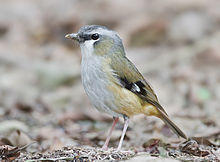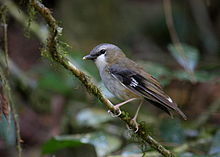| Grey-headed robin | |
|---|---|
 | |
| Scientific classification | |
| Kingdom: | Animalia |
| Phylum: | Chordata |
| Class: | Aves |
| Order: | Passeriformes |
| Family: | Petroicidae |
| Genus: | Heteromyias |
| Species: | H. cinereifrons |
| Binomial name | |
| Heteromyias cinereifrons (Ramsay, 1876) | |
| Synonyms | |
| |
The grey-headed robin (Heteromyias cinereifrons) is a species of bird in the family Petroicidae. It is found in northeastern Cape York Peninsula.
Taxonomy
It is one of two species within the genus Heteromyias. Previously, it and the ashy robin from New Guinea were treated as one species and known as Heteromyias albispecularis. Described by Australian naturalist Edward Pierson Ramsay in 1876, the grey-headed robin is a member of the Australasian robin family Petroicidae.[2][3] Sibley and Ahlquist's DNA-DNA hybridisation studies placed this group in a Corvida parvorder comprising many tropical and Australian passerines, including pardalotes, fairy-wrens, honeyeaters, and crows.[4] However, subsequent molecular research (and current consensus) places the robins as a very early offshoot of the Passerida, or "advanced" songbirds, within the songbird lineage.[5]
Description
The grey-headed robin has, as its name suggests, a grey crown and lores, white throat and olive-brown ear coverts and upperparts, with a white patch on the wings. The underparts are pale, the breast is pale grey, and the belly white. The bill and eyes are dark brown.[6]
Distribution and habitat
It is endemic to Queensland in Australia. The range in Australia is from Cardwell to the Bloomfield River in northeastern Queensland.[6] Its natural habitats are subtropical or tropical moist lowland forests and subtropical or tropical moist montane forests.
Behaviour
Breeding
Breeding occurs from August or September to January, with one or two broods per season. The nest is a shallow cup made of bark, grass, and dry leaves. Spider webs are used for binding or filling, and strips of fern and palm for lining; the outside is decorated by dried vegetation. The nest is generally placed in a lawyer vine up to 10 m (30 ft) above the ground. A clutch of one or two eggs is laid. The eggs are buff, cream- or dark greenish-white, and marked with light brown splotches and spots, usually concentrated around the large end, and they measure 26 by 19 mm.[7]
References
- ^ BirdLife International (2013). "Heteromyias albispecularis". IUCN Red List of Threatened Species. 2013. Retrieved 26 November 2013.
- ^ Gill, F and D Donsker, eds. (2020). IOC World Bird List (v 10.1). Doi 10.14344/IOC.ML.10.1. http://www.worldbirdnames.org/
- ^ Boles, Walter E. (1988). The Robins and Flycatchers of Australia. Sydney: Angus & Robertson. p. 35. ISBN 0-207-15400-7.
- ^ Sibley CG, Ahlquist JE (1990). Phylogeny and Classification of Birds: A Study in Molecular Evolution. New Haven, CT: Yale University Press. pp. 603, 610–27. ISBN 0-300-04085-7.
- ^ Barker, F. Keith; Cibois, Alice; Schikler, Peter A.; Feinstein, Julie; Cracraft, Joel (2004). "Phylogeny and diversification of the largest avian radiation" (pdf). PNAS. 101 (30): 11040–45. doi:10.1073/pnas.0401892101. PMC 503738. PMID 15263073. Retrieved 14 August 2008.
- ^ a b Slater, Peter (1974). A Field Guide to Australian Birds:Non-passerines. Adelaide: Rigby. p. 173. ISBN 0-85179-813-6.
- ^ Beruldsen, Gordon (2003). Australian Birds: Their Nests and Eggs. Kenmore Hills, Qld: self. p. 333. ISBN 0-646-42798-9.
- del Hoyo, J.; Elliot, A. & Christie D. (editors). (2007). Handbook of the Birds of the World. Volume 12: Picathartes to Tits and Chickadees. Lynx Edicions. ISBN 978-84-96553-42-2

